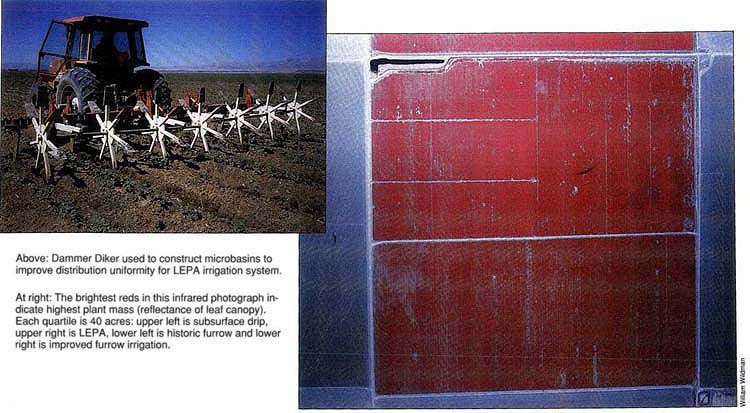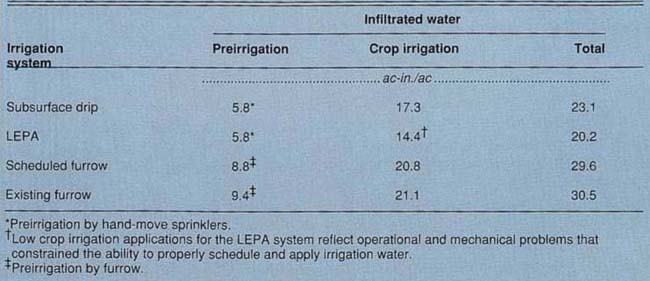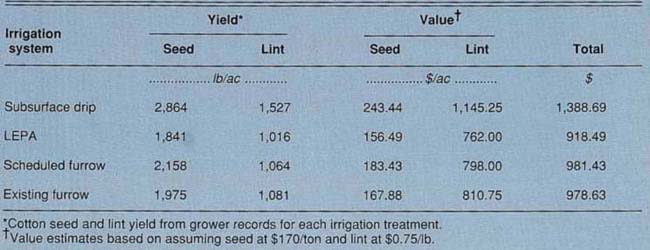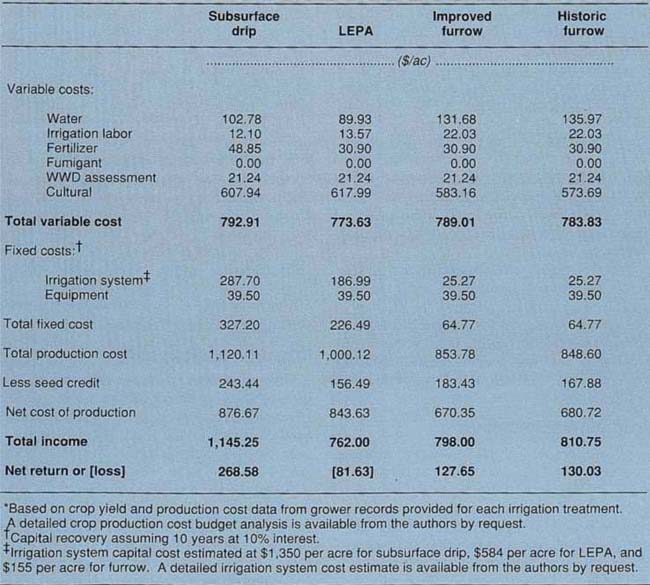All Issues
Subsurface drip produced highest net return in Westlands area study
Publication Information
California Agriculture 45(2):8-10.
Published March 01, 1991
PDF | Citation | Permissions
Abstract
Cotton was produced using subsurface drip, low-energy precision application (LEPA), scheduled furrow, and conventional furrow irrigation systems in 1989. Subsurface drip irrigation produced the highest net return to the grower through increased cotton yields. Significant water conservation was achieved with both pressurized irrigation systems (subsurface drip and LEPA). However, computer aided scheduling of furrow irrigation did not result in significant water savings. Pressurized irrigation systems may offer the flexibility and control necessary to significantly limit unnecessary water additions to the shallow groundwater table.
Full text
Editor's note: In the process of developing irrigation projects such as the one described in the previous article. a UC-sponsored work group recommended increasing the scale of demonstration projects and studying pressurized irrigation systems more intensively. The California Department of Water Resources agreed to fund these projects, one of which was the following.
In evaluating how drainwater disposal costs affect farm profits, the University of California Committee of Consultants on Drainwater Reduction concluded that maximum profits are achieved with furrow irrigation systems where there is no cost associated with drainwater disposal. Profitability decreased with increasing disposal costs; the rate of decrease was dependent on the infiltration uniformity achievable for each system. The lower the uniformity, the greater the rate of decrease. Where drainwater disposal costs exceeded about $75 per acre-foot, two pressurized irrigation systems — subsurface drip and low-energy precision application (LEPA) — were projected to be more profitable than furrow systems.
Boyle Engineering Corporation, under contract with the California Department of Water Resources Water Conservation Office, is testing this economic analysis (DWR project). The objective of this on-farm demonstration is to evaluate the effectiveness of subsurface drip and LEPA irrigation systems on reducing deep percolation losses and increasing grower profitability. These pressurized irrigation systems are also compared to existing and scheduled furrow irrigation systems. This paper summarizes data obtained during the first year (1989) of this project and compares them to those reported in the previous paper.
The DWR project site is located at Harris Farms in Westlands Water District, about 6 miles southwest of Five Points. The site consists of about 160 acres equally divided into four irrigation treatments. Soils are fine-textured with average soil profile salinity (0 to 24 inches) generally less than about 4 decisiemens per meter (dS/m). The project site is underlain by a shallow saline water table. Depth to groundwater ranges from about 24 to 30 inches in spring and early summer to about 72 to 84 inches in fall and early winter. The average shallow water table salinity ranges from about 4 to 11 dS/m. The site was planted to cotton (Ocala SJ-2) in 1989.
Irrigation systems
Subsurface Drip
The subsurface drip system uses 0.4 gallon-per-hour in-line emitters spaced at 40 inches along 0.52-inch inside diameter × 0.62-inch outside diameter polyethylene tubing. Spacing between tubing laterals is 80 inches. Tubes were buried 18 inches deep (±2 inches) in non wheel rows to minimize compaction problems.
Two buried PVC submains supply irrigation water to the laterals. Each submain is regulated by a 4-inch pressure-regulating valve. The drip tube is connected to the buried PVC pipe with a polyethylene hose riser. The riser is connected to a saddle glued onto the PVC pipe. Lateral runs are approximately 450 feet. The ends of each lateral are connected to a PVC pipe flush manifold. Each manifold has two manually operated flush valves.
A 30-horsepower booster pump supplies water to the system from a small reservoir. Filtration is performed by media filters filled with No.20 crushed silica media. The media has an approximate filtration capability of 200- to 250-mesh. The filtered water is metered before going into the PVC mainline. Nitrogen and phosphorus fertilizers, and sulfuric acid to prevent root intrusion, are injected with a venturi connected across the discharge and inlet of the booster pump.
The pressure-regulating valves at the submain inlets are set to regulate pressure at 25 psi. This corresponds to a system average discharge of 0.56 gallon per hour per emitter. The average application rate is 0.04 inches per hour. Overall calculated emission uniformity is 93%. The system runs approximately 8.5 hours per day to meet the average peak cotton evapotranspiration of 0.32 inches. Preirrigation was applied using hand-move sprinklers.
Above: Dammer Diker used to construct microbasins to improve distribution uniformity for LEPA irrigation system.At right: The brightest reds in this infrared photograph indicate highest plant mass (reflectance of leaf canopy). Each quartile is 40 acres: upper left is subsurface drip, upper right is LEPA, lower left is historic furrow and lower right is improved furrow irrigation.
LEPA
The low-energy precision application (LEPA) system is a linear converted to hose-drag operation. It is approximately one-quarter mile long and is constructed of 6 5/8-inch piping. There are seven spans of 178 feet each with a 40-foot overhang at the end. There are 43 booms attached to the main linear pipe. Most of the booms have nine outlets spaced 40 inches apart. At each outlet, there is a 3/4-inch, 15-psi pressure regulator and 15/128-inch brass nozzle connected to a 5/8-inch by 7-foot drop tube, and a furrow bubbler.
Water is pumped from a small reservoir using a diesel engine driven pump. The water is filtered by a rotating suction screen. This 18-mesh screen has interior water jets that rotate the screen and remove exterior debris. Pressurized water for the jets is supplied by the pump discharge. The pump feeds a surface aluminum pipe mainline going to the LEPA system. Six-inch riser valves are located about 340 feet from each end of the field, providing an attachment point for a 4-inch, 360-foot flexible drag hose.
The approximate discharge rate of each drop tube is 1.6 gallons per minute. Overall system capacity is about 610 gallons per minute. Assuming 85% to 90% uniformity, the system must be operated 10.5 to 11 hours per day to meet the average peak cotton evapotranspiration of 0.32 inches. Pre-irrigation was applied using hand-move sprinklers.
Furrow
Both the scheduled and existing furrow irrigation systems consisted of 10-inch gated pipe used on 40-inch beds. The scheduled furrow plot consisted of computer-aided irrigation scheduling, whereas the existing furrow plot was managed by the grower (check plot). Furrow length was approximately 1,190 feet with a slope of about 0.2%. Energy dissipation socks were placed on the gates to prevent soil erosion. Water supply was provided through a buried PVC pipeline connected to Westlands Water District facilities. A10-inch flow meter was connected at the pipeline discharge to record the volume of irrigation water applied.
Preirrigation was applied using all furrows. Alternate furrows were used for each of the four crop irrigations. The field was irrigated using blocked ends because tailwater collection/reuse facilities were not available. Set times were determined based on soil-water depletion and estimated soil intake rates.
Irrigation scheduling
Water content of the soil was monitored weekly with a neutron probe at three locations in each irrigation treatment with two access tubes per location. Irrigation scheduling was based on measured soil-water content, weather, and predicted plant evapotranspiration. Climate data was provided by the U. S. Department of Agriculture's California Irrigation Management Information System (CIMIS) weather station located at the University of California Westside Field Station. A computer program was used to model plant evapotranspiration.
For the subsurface drip and LEPA irrigation systems, the computer program was used to predict the total number of operating hours needed to satisfy plant evapotranspiration for the next 7 days. A water balance for the previous week was used to check the accuracy of the irrigation schedule.
For the scheduled furrow irrigation system, the computer program was used to predict frequency and duration of irrigation. The prediction limits were set by inputting the allowable soil moisture depletion, which was based on root zone depth, soil water-holding capacity, estimated soil intake rate, and irrigation system design and performance. Irrigations were scheduled by the grower on the existing furrow irrigation system based on experience.
Irrigation water application
Irrigation water applications summarized in table 1 were based on meter readings from each irrigation treatment. Preirrigation for the subsurface drip and LEPA treatments was applied using hand-move impact sprinklers. Lateral spacing was 45 feet with a 24-hour set time using 7/64-inch nozzles. Both furrow treatments were preirrigated using gated pipe and all furrows. The LEPA irrigation system had the lowest infiltrated water, which reflects operational and mechanical problems that constrained our ability to properly apply irrigation water. Irrigation scheduling provided little benefit with water infiltrated for both furrow treatments being nearly equivalent at 29.6 and 30.5 acre-inches per acre for the scheduled and existing furrow systems, respectively.
Net income for 1989
Crop yield and value for each irrigation treatment are summarized in table 2. The treatments were harvested individually using grower-owned and -operated equipment, and yield and value were determined from grower records. Variable and fixed crop production costs were obtained from grower records. Net crop return for the different irrigation treatments is summarized in table 3. Crop yield increases for the subsurface drip and decreases for the LEPA irrigation system affected the net income. Subsurface drip irrigation had the highest net income in 1989 ($268.58 per acre). The furrow plots had nearly identical net incomes: $130.03 per acre for the existing furrow and $127.65 per acre for the scheduled.
The LEPA irrigation system did not recover the production costs (net loss of $81.63 per acre). Operational and mechanical problems caused irrigation interruptions, which may have resulted in plant stress and subsequent reduced boll set. The 1989 results from the LEPA treatment do not fairly represent yields and returns that may be achieved from this system under normal operating conditions.
Summary and conclusions
Based on the 1989 results from the DWR demonstration project, the following conclusions can be drawn:
-
Pressurized irrigation systems are more costly to install, operate, and maintain compared to furrow irrigation.
-
Increased crop yield and gross returns are needed to compensate for increased subsurface drip and LEPA irrigation system costs.
-
Computer-aided scheduling of furrow irrigation did not result in significant water savings.
-
Reductions in subsurface drainwater disposal costs and increases in the ability to sustain long-term irrigation and agriculture in the western San Joaquin Valley may be additional economic benefits.
-
Pressurized irrigation systems need further evaluation under western San Joaquin Valley conditions to develop a better understanding of the long-term management requirements and profitability.








